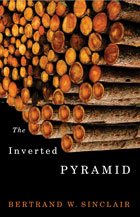The Inverted Pyramid
Review By Sinead Earley
November 4, 2013
BC Studies no. 179 Autumn 2013 | p. 232-234
In 2011, the Association of Book Publishers of British Columbia celebrated Vancouver’s 125th anniversary with the Vancouver Legacy Book Collection, reissuing ten books that it deemed best representative of British Columbia’s social and literary history. Each of the selected books reveal certain inner workings and undercurrents of British Columbia’s past, but it is Bertrand Sinclair’s 1924 novel The Inverted Pyramid that touches most directly on what is arguably the province’s principal legacy: the extraction, commodification, and export of its natural resources.
The Inverted Pyramid is loosely based on the history of the Dominion Trust Company, which collapsed in 1914 due to a combination of highly speculative lending practices and an abrupt drop in real estate prices. The narrative traces the lives of the Norquay brothers, who gained life experience and lost family fortunes in an age when the relationships between people, public lands, timber rights, and the ethics of modern business were especially tenuous. The Norquay fortune is shown as having its origins in their lucrative timber holdings, but the family business is subsequently redirected from the thick coastal forestlands to Vancouver’s urban skyline as the city’s financial sector rapidly grew. Grove, the eldest brother, is the speculative capitalist intent on establishing the Norquay Trust Company as a major financial institution. In contrast, Sinclair’s protagonist, Rod, the youngest Norquay brother, is a veritable seer. He is a character so uncomfortable with his own forecasting insights that fraternal bonds are violently broken as brothers feud over dispensing the family fortune.
Sinclair offers evocative descriptions of working life in British Columbia’s forests during the interwar years. Rod is the novel’s existentialist, constantly defying the class boundaries he has struggled with since youth. He insists on gaining worldly knowledge through manual labour, “through experience — plus imagination” (86), and learns to live and to work in logging camps. Rod entered camp life as discharged soldiers re-entered the labour market and disputes over living conditions, wages and strikes were on the rise. Sinclair portrays the period as one in which “industrial war was secretly declared” against the “militant logger” (239), yet he also hints at an emerging conservationist consciousness. The patriarch of the family expresses the need for experts in the field, “to teach them how to get one prime stick to the booming ground without destroying twice as much more…they’re skimming the cream of the forest, spilling half of it” (82).
The acute irony in Sinclair’s novel is that when Grove’s moneyed aspirations disintegrate and the Norquay Trust Company declares bankruptcy, it is left to Rod, who had developed deep compassion for the forest and those who laboured in it, to dispose of the family’s timber holdings. In the wake of his brother’s speculative ethos, Rod Norquay was forced to orchestrate the devastation of a landscape, and along with it the ruin of the family legacy itself.
It is always difficult to decide what constitutes a literary “classic.” It is evident by the multiple ways in which The Inverted Pyramid still speaks to current readers — in times of timber supply crises, mill closures, economic recession, banking troubles, and real estate worries — that Sinclair’s allegories remain noteworthy almost a century later. Those who seek a deeper understanding of British Columbia’s forest history will find it in Sinclair’s words, which are expressed in a visceral style that is easily accessible. The novel lends insight to current issues in forestry, most particularly to the complicated metropole-hinterland relations that exist in the province. In this regard, Sinclair offers what other “classic” authors of the early forest industry, such as M.A. Grainger or Roderick Haig-Brown, do not. He steps beyond “life in the woods” to convey how every cut in the forest is a highly localized and personal act, as well as one piece among many in an international, financial spectacle.
The Inverted Pyramid
By Bertrand Sinclair
Vancouver: Ronsdale Press, 2011. 328 pp. $18.95 paper. First published in Boston by Little, Brown, and Company, 1924

